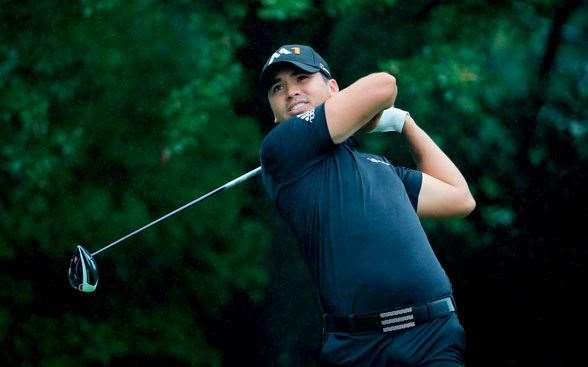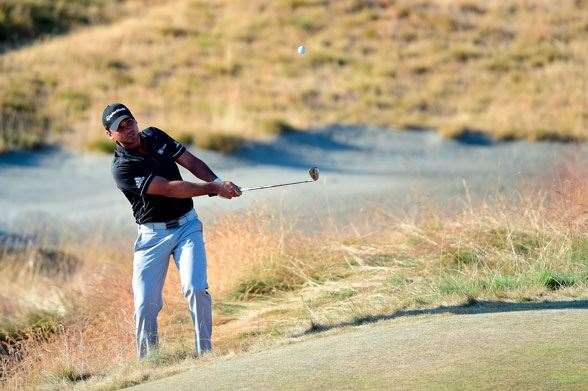Golfer claims our annual athlete-of-the-year gong.
On-fire golfer claims our annual athlete-of-the-year gong. Here are the many reasons why ...
 (Photo by Getty Images)
(Photo by Getty Images)Late in 2007, having just completed his first year as a professional golfer, Jason Day created a stir by declaring he wanted to be world no.1 one day. Innocent enough for a talented 20-year-old, except for the fact that the Tiger era was still in bloom, and this rookie had the temerity to say he would “take down” Woods.
It was one of those quotes ripe for misunderstanding, an unfortunate way to introduce yourself to a wider golf-following world which was hearing from you for the first time. It entirely bypassed all context; Day wasn’t dissing Tiger but instead aiming up at his inspiration, as it was Woods’ own amazing story that inspired him growing up in Queensland. The statements sounded like those of the typical brash upstart, but they obscured a relevant fact – this was a kid with a rare kind of talent, and a hard-knocks work ethic that could make good on it.
Jason Day wasn’t cocky. Still isn’t. As he now sits as the top-ranked golfer on the planet, he wouldn’t take the bait. “I’d love to say ‘I told you so’,” Day said after the PGA Tour win in Illinois that sealed his rise to no.1, “but it wouldn’t be nice.”
While the tennis brats’ behaviour throughout the year was causing the nation’s angst level to spike, it was Day’s example that stood in stark contrast. When he made his big breakthrough last August, claiming the PGA Championship in Wisconsin and denying Jordan Spieth a third major title for 2015, prominent American sports anchor Scott Van Pelt noted that because Day was so liked, his victory would be a popular one within the sport. Another golf commentator, the rather candid Brandel Chamblee, said he saw a bit of Arnold Palmer quality in Day. False politesse rules on the coldly competitive golf tour, and radars are keenly attuned for specks of genuine feeling. Like his countryman and fellow member of the no.1 golfer circle, Adam Scott, the congenial Day’s ascension to champion status was hugely well-received.
It was recognition, perhaps, that a good guy who had overcome a lot had finally got his due. At the US Open in June, Day was involved in one of the golf year’s most dramatic moments. During the second round, Day collapsed from a bout of vertigo, a condition that had periodically afflicted him for five years and had forced him to withdraw from a tournament just weeks before the US Open. The dizzy spells were the oddest entry in a litany of ailments that have cropped up over his career, including wrist, thumb and back injuries.
Prostrate on the grass of the Chambers Bay course in Washington, all manner of worst-case scenarios for Day could be imagined. Career death for sure; having a condition that affects balance is a tough thing to deal with for a pro golfer. About the best that could be said for it was it happened close to the end of the round, and Day was able to stumble to the clubhouse. But the next day, still woozy and leaning on caddie/mentor Col Swatton at times, Day shot an incredible 68 to tie for the lead. He would be surpassed on the Sunday, both by the eventual winner Spieth and the follies commonly found at the toughest of the four majors. But Day had authored an all-time moment in golfing grit.
A month later, he was there again at the Open Championship, tied for the lead after 54 holes at St Andrews but in the end a shot short of the play-off. This was familiar territory. In 20 career appearances, Day had already amassed six top-five finishes, which was something of a double-edged sword – he was a proven performer in the most important events of the year, but was also building up a record of falling short, and sometimes looked like he was getting in his own way. Major victory seemed like it would eventually come for Day, but golf is littered with almost-great players still waiting on the inevitable.
 (Photo by Getty Images)
(Photo by Getty Images)One of the cruel and capricious truths of the majors is in how they are won: some are a slog, some a knife-edge walk, others fall in a player’s lap. To get his first, Day had to play flat-out brilliantly, holding off a rival on his own historic run of form and setting a major-championship scoring record. The host course, Whistling Straits, is a stern test, but Day overpowered it on his way to 20-under-par. Even with Spieth staring him down in the last group, Day out-shot him and won clear by three strokes.
It was a commanding performance that many knew was possible, particularly people within Australian golf. Day was one of the brightest ever prospects from the nation’s junior and amateur ranks when he emerged in the mid-2000s, a story all the more intriguing for the hardship in his background. Day was a teen when his father Alvin died, and his family life was often unstable: Alvin was a drinker who would beat his son, and Day’s sister once ran away from home. Day and his Filipina mother, Dening, were living in Rockhampton when the boy’s sporting pursuits led him to schools in south-east Queensland. It was there he met Swatton, who after an initial bust-up, became coach, counsel and father figure. They reined in some youthful acting-out, and began to cultivate a remarkable golfing gift.
Day’s talent is undeniable. Technically solid, powerful off the tee (he hits the highest ball on the PGA Tour) and daring around the greens, only Rory McIlroy and perhaps Dustin Johnson compare for raw ability. But what turned him from hotshot into worldbeater is an ever-present diligence. Day is highly process-driven, fluent in the language of self-improvement. And for all the difficulties in his childhood, the big thing that was impressed upon him was the value of work.
Having made quick money soon after landing on tour, Day went through an early form slump that he later explained as an adjustment period – having had nothing for so long, the abundance granted to a world-class golfer was jarring. What stands out about Day now, particularly compared to his nascent rivals Spieth and McIlroy, is how settled he’s become at the age of 28: wife Ellie, three-year-old son Dash, new baby, home in Ohio, Swatton on the bag, the same management team since he turned pro. Whether or not he has things figured out, it looked that way on the course – having won three PGA Tour tournaments in his first eight seasons, he won five in 2015, with victories at Torrey Pines, in Canada, and the FedEx Cup play-off events in New York and Illinois as well as the PGA. This tied Jim Ferrier’s mark for most US wins in a season by an Australian, while the prizemoney made – almost $13m – smashed all previous records. When he reached the top of the world golf rankings in late September, he became the 19th individual male to join the elite circle since the system was inaugurated in 1986. He also became the third Australian to achieve the feat, with Scott and Greg Norman, and to the deep pride of a certain northern state, no doubt, all of the Aussie world no.1s hail from Queensland.
About the only things he didn’t win were the tour’s season-ending jackpot, and the player-of-the-year award, which went to Spieth. As the no.1 ranking bounced around in the latter part of the year, Day is now part of a multi-way tilt for the mantle of world’s best golfer. They came to take down Tiger, but now find themselves taking aim at each other. And for Day, and the rest of us, that might be the most exciting prospect of all – to stay at no.1, there will be more improvement to be made. And the thought of how good that might be is, well, dizzying.
Related Articles

The Aussies at The Open

Feature Story: Familiar but fierce













